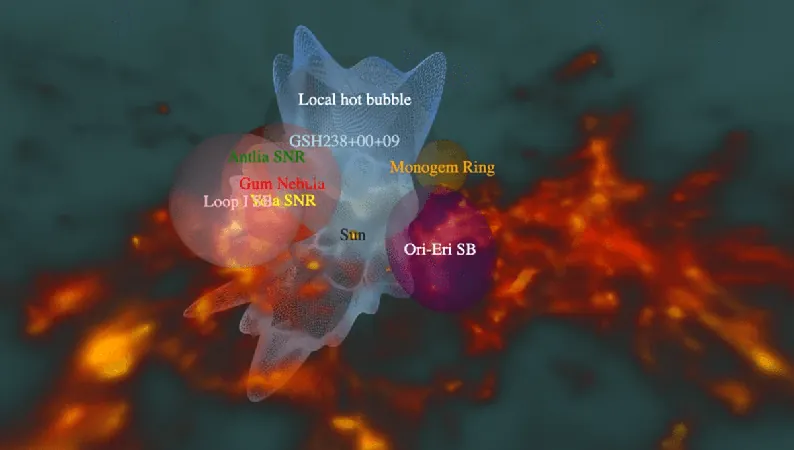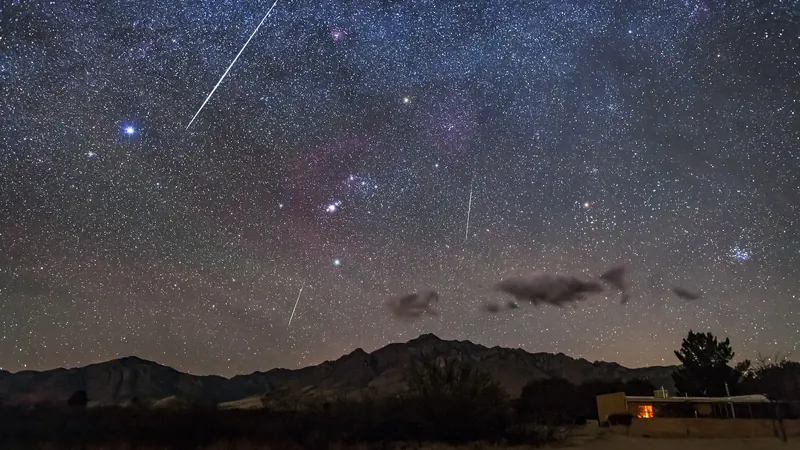
Astronomers Uncover 'Interstellar Tunnel' Linking Our Solar System to Centaurus – What This Means!
2024-11-11
Author: Nur
Groundbreaking Discovery
A groundbreaking discovery by a team of astronomers using data from the eROSITA All-Sky Survey has unveiled a mysterious phenomenon known as an 'interstellar tunnel' directed towards the constellation of Centaurus. This tunnel potentially serves as a bridge, connecting our own 'Local Bubble' to a nearby superbubble, further expanding our understanding of the cosmos.
The Local Bubble Explained
Our Solar System resides in a vast region known as the 'Local Bubble,' measuring about 1,000 light-years in diameter. This area, sometimes referred to as the 'Local Hot Bubble' (LHB), boasts a significantly lower density than typical interstellar space, containing just 0.001 particles per cubic centimeter—compared to the much denser typical cloud which harbors 0.1 particles per cubic centimeter. The concept of the Local Bubble has been around for nearly fifty years, prompting scientists to explore its origins and implications for our solar system's environment.
The Historical Context
It's essential to note that humanity has not always existed within the confines of this bubble. The transitions between different densities of space may have influenced our climatic conditions in profound ways throughout astronomical history. Consequently, studying this region in depth could be crucial for understanding our cosmic home over the next 10 to 20 million years.
Formation Theories
Recent research has explored how this peculiar region, seemingly lacking in neutral gas, came into being. Researchers propose that the formation of the LHB may stem from numerous supernova explosions, drawing on a combination of historical star cluster trajectories, advanced numerical simulations, and evidence of supernova-produced radioisotopes found in Earth's crust.
The Role of eROSITA
Using the eROSITA telescope—a collaborative project between Russian and German institutions aimed at mapping the universe in X-rays—a team led by scientists from the Max Planck Institute for Extraterrestrial Physics has produced a new model to visualize this cosmic phenomenon. Their findings indicate a greater concentration of hot gas at the galactic poles, as this hot material takes the path of least resistance, moving away from the galactic disc, an observation that aligns with earlier findings from the ROSAT survey.
Insights from Researchers
Co-author Michael Freyberg expressed excitement about the discovery of the Centaurus tunnel, stating, 'What we didn’t know was the existence of an interstellar tunnel towards Centaurus, which carves a gap in the cooler interstellar medium (ISM). This region stands out in stark relief thanks to the much-improved sensitivity of eROSITA.'
Significance and Future Research
The implications of this tunnel are significant; researchers believe it may be filled with hot plasma and potentially connect our Local Bubble to the Loop I superbubble, an enormous region formed by past supernovae. However, much remains unknown about the tunnel, as its study is complicated by the presence of other colossal cosmic structures nearby.
Challenges in Analysis
The researchers noted that 'The Centaurus tunnel region is located on the edge of the eROSITA bubbles, further complicating the spectral fitting,' and emphasized the need for dedicated spectral analysis to separate the emissions from the Loop I superbubble from the eROSITA bubbles.
Looking Ahead
Additional investigations and cosmic studies are already underway, promising to shed more light on this remarkable discovery. As we delve deeper into our universe, who knows what other secrets may be waiting to be uncovered? Stay tuned for more revelations from the realm of astrophysics!

 Brasil (PT)
Brasil (PT)
 Canada (EN)
Canada (EN)
 Chile (ES)
Chile (ES)
 Česko (CS)
Česko (CS)
 대한민국 (KO)
대한민국 (KO)
 España (ES)
España (ES)
 France (FR)
France (FR)
 Hong Kong (EN)
Hong Kong (EN)
 Italia (IT)
Italia (IT)
 日本 (JA)
日本 (JA)
 Magyarország (HU)
Magyarország (HU)
 Norge (NO)
Norge (NO)
 Polska (PL)
Polska (PL)
 Schweiz (DE)
Schweiz (DE)
 Singapore (EN)
Singapore (EN)
 Sverige (SV)
Sverige (SV)
 Suomi (FI)
Suomi (FI)
 Türkiye (TR)
Türkiye (TR)
 الإمارات العربية المتحدة (AR)
الإمارات العربية المتحدة (AR)